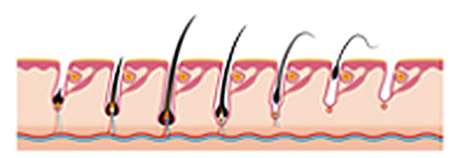| |
|
Hair Stucture |
|
| |
|
|
| The cuticle is the outermost part of the hair shaft and is responsible for providing protection for it. |
|
| |
|
|
The cortex is the middle layer of the hair shaft. It affects the texture of hair and contains pigments that determines the hair colour. |
| |
|
|
The innermost layer of the hair shaft that makes up of cells with air spaces in between. It only exists in large and thick hair. |
| |
|
|
Contain vascular loops and specialized nerve endings. It provides growing hair with nutrients and oxygen. When destroyed, hair growth will be put into a halt and lead to hair loss. |
| |
|
|
Secretes sebum for protecting the scalps. |
|
 |
|
| |
|
| |
| |
| |
Hair Growth Cycle |
| The Hair Growth Cycle can generally be divided into three phases: the Active Growing Phase (Anagen), the Transition Phase (Catagen) and the Resting Phase (Telogen). |
| |
|
|
 |
| |
The Active Growing Phase (Anagen)
|
|
| Hair continuously grows. The growth period can last from 2 to 5 years. |
|
|
| The Transition Phase (Catagen) |
|
| Hair stops growing and slowly detaches from the nutrient-providing blood vessels and leaves the follicle. This lasts several weeks. |
|
|
| The Resting Phase(Telogen) |
|
Hair slowly detaches and stay loosely on the scalps. It will be shed in a few months’ time or will be pushed out by newly grown hair.
|
|
|
|
|
|
|
| |
| |
Hair is made up of a strong protein, Keratin. |
When the protein from food is dissolved by digestive enzymes, they transform into different types of amino acids that go through capillaries to the dermal papilla. The dermal papilla will then absorb nutrients and carry out protein synthesis and keratinized as hair.
There are 18 types of amino acids that is help creates hair: Cystine, Glutamic acid, Arginine, Glycine, Leucine, Tryptophan, Serine, Serine, Valine, Alanine, Proline, Tyrosine, Phenylalanine, Lysine, Isoleucine, DL-Methionine, Histidine, Aspartic acid.
Hair growth requires hair cells to absorb vital nutrients, amino acids, from the capillaries from the dermal papilla. Each hair follicle contains 2-3 sebaceous glands for sebum supply which makes hair soft. The amount of sebum production of hair determines whether the hair is dry, oily or normal hair type.
|
| |
| (Sebum) |
| Sebum is a fatty substance excreted by the sebaceous glands in the hair follicle. It makes hair glossy and luminous while being waterproof. |
| |
| (Dandruff) |
| Dandruff can be divided into two types: dry and wet. Dry dandruff can be classified as having too much dry scalp on head that does not come with scalp redness or yellowish, oily scalp. The appearance of dry dandruff resembles snowflakes. Wet dandruff, on the other hand, is the seborrheic dermatitis in the scalp. Other than having too much dandruff, there would be scalp redness and oily flakes on the head, accompanied by inflammation, swelling and itchiness that changes with the seasons. In addition to that, the consumption of spicy, greasy food and a lack of sleep may worsen such condition. |
| |
| (Irritated Scalp) |
There are a number of reasons leading to irritated scalp and it is different from person to person. For instance, unsuitable hair dye, medication or pollen can cause irritated scalp.
Small blisters between the flesh and dermis may appear on the irritated scalp and it may look like a large piece of uneven, reddish swell in appearance. |
|
| |
|

